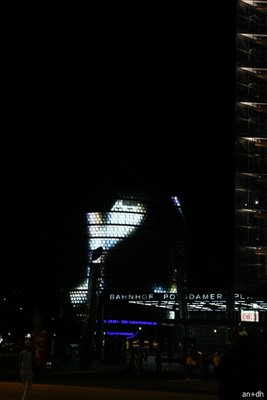 in any major cities, one sight one can not escape is the use of state of the art LED lighting. its lifespan long, able to produce spectrum of colours, and can even orchestrated into a light show with proper programming. the problem is, while our cities become increasingly more colourful, our sense becomes more numb as we are losing our feelings towards some of these vibrant but meaningless pixels.
in any major cities, one sight one can not escape is the use of state of the art LED lighting. its lifespan long, able to produce spectrum of colours, and can even orchestrated into a light show with proper programming. the problem is, while our cities become increasingly more colourful, our sense becomes more numb as we are losing our feelings towards some of these vibrant but meaningless pixels.
so when we saw this SPOTS installation at The Park Kolonnaden complex at Postdamer Platz, were instantly attracted to it. so it doesn't have colour, but its simplicity made the message stood out. the system apparently employed DALI (Digital Addressable Lighting Interface) system and able to capture images and redisplay them on the facade. interestingly enough, it is using none other than ordinary fluorescent tubes, the magic lies in the electronic control gear (ECG).
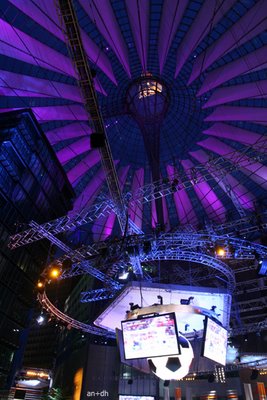 during the worldcup period, if you couldn't book a ticket to enter the stadium and watch the match live, or that you didn't want to stay in the hotel to watch the tiny television, the best place to be, if you were in Berlin, was the Postdamer Platz.
during the worldcup period, if you couldn't book a ticket to enter the stadium and watch the match live, or that you didn't want to stay in the hotel to watch the tiny television, the best place to be, if you were in Berlin, was the Postdamer Platz.
you paid for an entry fee so that you could get a seat at the atrium where the huge television screen was. the price included food and drinks and were not overpriced, something we appreciated a lot. Germany was serious and focus in the events they organized, and they seldom use it as a marketing tool to extract money from visiting tourist.
the place was in fact a cluster of office buildings and entertainment venues, masterplanned by Hilmer, Sattler & Albrecht, the buildings themselves were the works of a number of different architects including names like Renzo Piano, Helmut Jahn, Richard Rogers, Arata Isozaki...etc.
the roof feature added the sense of volume in this space and was lit up with floodlights of various colours, a night marvel in itself.
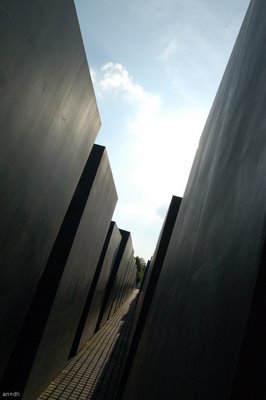 perhaps one of the most controversial race on earth, the Jewish population has endured some of the most frightening experience during the WW2.
perhaps one of the most controversial race on earth, the Jewish population has endured some of the most frightening experience during the WW2.
one can read books, watch movies, or even visit historical sites related to the holocaust, but how close could one imagine or even attempting to understand the fear, hopelessness, despair that the Jewish people experienced?
went into the Memorial to the Murdered Jews around 3pm on a sunny weekday, at the height of the WorldCup fever, yet, once you entered the orthogonal laybirith, with the floor undulating in unexpected ways, and the concrete columns suddenly towering over you at the heart of the installation, the chill that sent thru your spine, so many people around you yet you can not see them, hearing voices muttering but not knowing their whereabout, one was suddenly catpulted back to a dimension where there was no hope, and the future was bleak...
other than a piece of work by Tadao Ando in Himeji i visited years ago that gave me such a strong impact, this installation has hit home a sensation that can not be described in words...i was speechless, and felt that i was among the Jews, waiting to be escorted to the path of utter darkness...
this is the power of architecture.
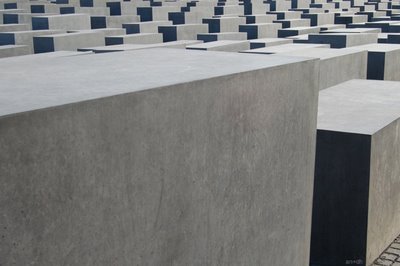 maybe due to the kind of media exposed to, or never have been to one of the built works, or indifference to his architectural philosophy in relation to the complexity theory, never particularly liked Peter Eisenman's works.
maybe due to the kind of media exposed to, or never have been to one of the built works, or indifference to his architectural philosophy in relation to the complexity theory, never particularly liked Peter Eisenman's works.
after visiting the memorial of murdered jews in Berlin, however, have somehow changed my attitude towards his work.
there's a certain delicate treatment to the seemingly unimaginative rows of upright concrete slab. from a distance, it was overwheming due to its sheer size, and monumental solemness. but it's only when you enter this concrete maze, then you realize it's more than what one could anticipate...
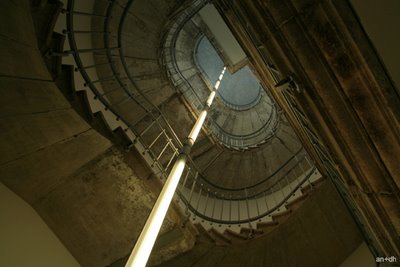 there was a whole lot of architecture to be seen close to the Brandengurger Tor, and any attempt to see all in one day would simply spoil the marvels. it was a hot day, and we were dying for a drink, walked past this building, not knowing what it was, but could see a bookshop, a bar and some funny looking installation through the curtain wall on the front. unlike some of the buildings nearby (as it was already 5 in the afternoon), the doors were unlocked, we entered, and found out this was actually the akademie der kunste. not that we didn't know it exist before hand, but our main objective after visting the Brandengurger Tor was actually the Memorial to the Murdererd Jews. so discovering the akademie was a pleasant surprise.
there was a whole lot of architecture to be seen close to the Brandengurger Tor, and any attempt to see all in one day would simply spoil the marvels. it was a hot day, and we were dying for a drink, walked past this building, not knowing what it was, but could see a bookshop, a bar and some funny looking installation through the curtain wall on the front. unlike some of the buildings nearby (as it was already 5 in the afternoon), the doors were unlocked, we entered, and found out this was actually the akademie der kunste. not that we didn't know it exist before hand, but our main objective after visting the Brandengurger Tor was actually the Memorial to the Murdererd Jews. so discovering the akademie was a pleasant surprise.
there was an exhibition going on with large scale installations, some rather interesting works. but it was this staircase which caught my attention most...
of this building, everything seems to be very architectural of the contemporary era, steel staircase, angled glass, white walls, self-leveled flooring, slanted furniture...and suddenly, saw a staircase which was totally unsimilar to any of its surroundings, something from another moment in history...made me wonder was this all that remains from its previous incarnation, or was it a replica of somewhere inserted into this space?
took the steps, heard sound from above, anticipating an encounter of of an unusal kind...
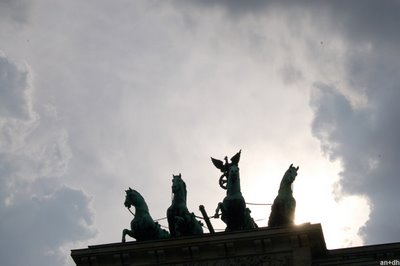 what once stood in East Germany and overlooking the many events happened before the removal of the Berlin Wall, this Neo-classical structure, modelled after the Athenian Propylaea, with Victoria, the goddess of victory, driving the Quadriga.
what once stood in East Germany and overlooking the many events happened before the removal of the Berlin Wall, this Neo-classical structure, modelled after the Athenian Propylaea, with Victoria, the goddess of victory, driving the Quadriga.
located at the end of Unter den Linden.
there was a very useful tourist information centre just by the side of the gate which has ample information on architecture, but watch out for the date when it is closed!
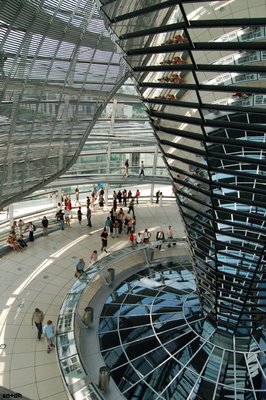 the massive mirror fixture, apart from giving some very nice reflections through its tilted angle fixings and becoming the central focus of the enclosure, serves another purpose of bringing in the natural day light through to the assembly hall below.
the massive mirror fixture, apart from giving some very nice reflections through its tilted angle fixings and becoming the central focus of the enclosure, serves another purpose of bringing in the natural day light through to the assembly hall below.
the glazed roof of the hall, which is transparent for the public to look into, perhaps symbolize the transparency of the government...but while you can see inside, you can't really hear what's going on inside, a bit ironic...
while expecting the details to be hinged of joints, and allow the fixings to a certain degree of movement, was surprised to see most are welded joints...
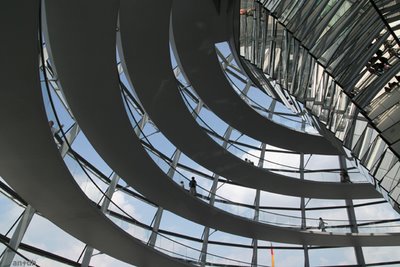 designed by Foster and Partners of United Kingdom, this piece of architecture easily top the list of must visit site in Berlin. it's free of charge to get in, but due to all the security check, expect to queue outside for a bit before you are eventually admitted into the premises.
designed by Foster and Partners of United Kingdom, this piece of architecture easily top the list of must visit site in Berlin. it's free of charge to get in, but due to all the security check, expect to queue outside for a bit before you are eventually admitted into the premises.
once inside, the elevator will take you to the roof of where the iconic copola is. there is plenty of information regarding the background of this project listed in the architect's homepage.
the day when we visited was at the height of summer, and this glass structure was in fact not air-conditioned but relying on stack effect and natural ventilation through the openings on the screen. was it effective? of course not as comfortable as a fully air-conditioned building, but comparing to the heat on the street, this was not so bad.
2 parallel running ramps encircle the inside skin of this architecture and can take you all the way to the top, which is opened to the sky, uncovered! quite a surprise.
this place deserves another entry to talk about.







